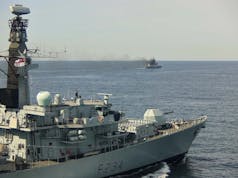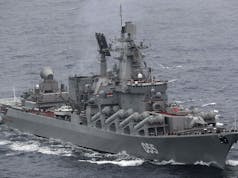New navigation radar systems will be fitted to more than 60 Royal Navy ships, submarines and shore facilities as part of a £44 million contract.
The Ministry of Defence (MoD) has awarded Lockheed Martin a £44 million contract for navigation radars for more than 60 Royal Navy ships, submarines and shore facilities.
The contract with Lockheed Martin will cover the demonstration, manufacture and in-service support for the Kelvin Hughes designed system. It will sustain 14 jobs at Lockheed Martin’s Havant facility and create five additional roles in the company.
Over the next five years, the MoD’s Navigation Radar Programme will replace existing radars fitted across the fleet and shore facilities with solid-state SharpEye radar transceivers designed and developed in the UK by Kelvin Hughes in Enfield North London.
SharpEye makes use of S-Band radar technology for safety, navigation and collision avoidance at sea. According the manufacturer:
SharpEye transmits a low power patented pulse sequence, which enables short, medium and long range radar returns to be detected simultaneously, allowing the radar operator to maintain situational awareness regardless of the range scale setting of the radar display and other users of the radar can select their own radar display range scale. A low peak transmission power less than 200W is equivalent to a 30kW magnetron. Solid state radar ensures extremely high reliability and low through life costs:
- No magnetron – minimal routine maintenance requirements
- High reliability – solid state electronics
- Upmast transceiver solution – no waveguide – easy to retrofit – reduced signal loss
- Clutter suppression – pulse compression
- Continuous health monitor
Defence Minister Philip Dunne said:
“The replacement of navigation radars across more than 60 ships, submarines and shore facilities will see the Royal Navy receive the latest generation of digital radar systems which set the standard for the future.
This has been as a direct result of our pledge to invest £178 billion in defence equipment and support, to help to ensure the UK can respond to diverse threats around the world.”
Shore facilities will also benefit from the new technology, including training equipment at HMS Collingwood, in Hampshire, HMS Raleigh, in Cornwall, and at the Land Based Test Site at Portsdown Technology Park in Hampshire.
Head of Maritime Combat Systems at the MOD’s Defence, Equipment and Support Organisation, Steve Hyde, added:
“This contract will see new radars that use the latest technology rolled out across the entire Royal Navy fleet, providing a reliable, technically capable and easy to maintain system that will give our Navy the extra confidence they need when serving on operations.”
It will sustain 14 jobs at Lockheed Martin’s Havant facility and create five additional roles in the company.
Kelvin Hughes is a designer and manufacturer of navigation and surveillance systems and a supplier of navigational data to both the commercial marine and government marketplace.
Kelvin Hughes provides surveillance and navigation systems to 30 of the world’s navies according to their website. Kelvin Hughes Surveillance solutions span both land and sea; from border security and civil infrastructure integrated surveillance systems to naval integrated bridge systems, solid-state surveillance radar and radomes for small fast boats, including the world’s largest ocean liner, RMS Queen Mary 2.













Not on the pictured type 45s though?
Excellent
Do we have 60 ships
Some good radar news George
Allan, i’ll see your radar news and raise you seawater antenna news: http://www.gizmodo.co.uk/2016/01/mitsubishi-has-made-an-antenna-out-of-seawater/
No point, get rid of it
The phrase, “more than 60 Royal Navy ships, submarines and shore facilities”, makes it sound like we’ve got lots of ships!